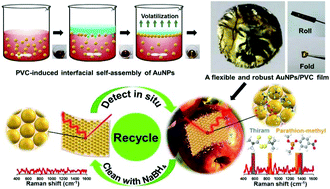Polymer induced one-step interfacial self-assembly method for the fabrication of flexible, robust and free-standing SERS substrates for rapid on-site detection of pesticide residues†
Abstract
We have demonstrated a one-step approach for the fabrication of flexible, robust, reproducible and free-standing SERS substrates (AuNPs/polyvinyl chloride (PVC) film) through a polymer induced interfacial self-assembly method. In this method, the polymer (PVC) plays dual roles, that is, inducing the interfacial self-assembly of nanoparticles and fixing the assembled nanostructure in the PVC matrix. As the assembled nanoparticles are orderly half-embedded in the PVC film, the AuNPs/PVC film exhibits outstanding reproducibility and stability. In addition, the film could be easily regenerated by rinsing with NaBH4 solution. As a proof of concept, the film was directly wrapped on an apple surface for in situ detection of pesticide residues, and a detection limit of 10 ng cm−2 thiram was achieved. Furthermore, rapid on-site and in situ detection of multi-pesticide residues has been proved to be feasible with the aid of a portable Raman spectrometer. Due to its simple preparation, good reliability, outstanding stability and reusability, the AuNPs/PVC film has great potential in practical applications.



 Please wait while we load your content...
Please wait while we load your content...